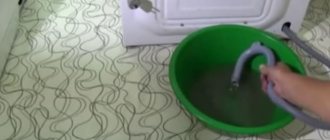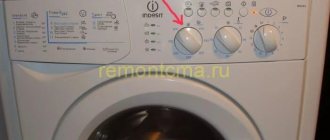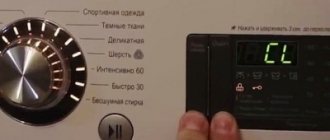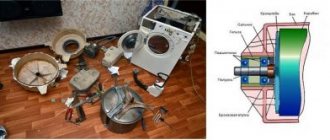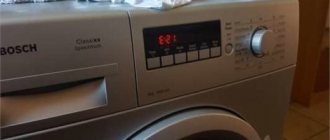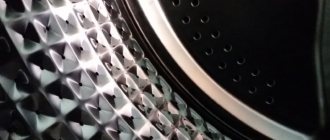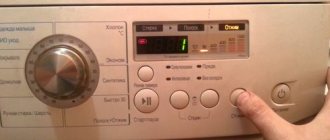It happens that after washing is completed, the laundry remains wet. If things feel wet to the touch, and not just slightly damp, or water flows from them like a river, the washing machine does not spin out the laundry. But we’ll figure it out why.
The good news is that you can often fix the breakdown yourself. The main thing is to diagnose the problem.
The manual is universal and is suitable for all vertical and horizontal models of the brands Ariston, Bosch, Candy, Gorenje, Indesit, Samsung, Siemens, Zanussi, Ariston, Bosch, Aeg, Beko, Electrolux, Haier and others.
To start
If the problem has appeared for the first time, it is too early to sound the alarm. Maybe the reason is not a breakdown. First of all, go through the following points and check if everything is in order.
“No spin” program selected
Check the icons on the dashboard. You may have accidentally selected a washing program that does not involve spinning.
Balancing the washing machine drum
An imbalance may have appeared in the washing machine - the laundry has overlapped each other, forming one large lump of things. To fix this, you need to center the drum. Open the hatch and distribute the laundry evenly throughout the entire volume of the centrifuge. From now on, when loading things, try to avoid imbalance and we recommend reading the operating instructions - modern washing machines sometimes have an automatic adjustment function.
When spinning, the machine may rattle and jump on the floor from side to side:
- The drum is unbalanced - the crosspiece fastenings may have become loose, the shaft is bent, or the ribs or body are damaged. The part is made of stainless steel, so it must be handled carefully.
- The transport bolts have not been removed.
- The shock absorbers have failed.
Load Exceeded
Each machine’s passport indicates how many kilograms it is designed for, usually from 3 to 8 kg. If the permissible weight is significantly exceeded, the centrifuge will become loose, and strings and holes will appear on your favorite things. This is especially true for delicate items, such as a down jacket. The way out of this situation is to remove the excess laundry. It’s better to wash it twice than to spend money on repairs later.
Blockage
A blockage has formed in the filter or siphon, which prevents water from flowing into the sewer. The control unit does not give a command to pump out liquid after washing, and does not start spinning.
- First, you should inspect the drain filter.
- If it is in order, check the siphon and connection to the drain. You can clean these parts yourself.
- Another thing is if the pump pipe (drain pump) is clogged. You will have to disassemble part of the washing machine or entrust it to a specialist.
The interference filter is broken
This filter protects the automatic washing machine from power surges. This is a board with capacitors that is installed inside the “washing machine” body. The power cord from the outlet is connected to it. Sometimes, after severe power changes, the wash “freezes” and the program does not start spinning.
You can diagnose the breakdown and replace the element yourself. But when it comes to electrical work, it's best to leave the job to a professional.
Possible reasons
Often, the lack of spinning does not affect other functions: the automatic machine continues to properly wash and rinse clothes, but after the end of the cycle, the contents of the drum remain wet. If the washing machine does not spin, the reasons may be as follows:
- incorrectly selected program;
- drum overload or imbalance;
- no drainage;
- tachometer failure;
- wear of engine parts;
- problems with the control unit.
To understand why the washing machine does not spin clothes, you need to eliminate each of the possible causes in turn.
Depending on the situation, you can restore the spin cycle in the washing machine either at home or in a service center. Next we will take a closer look at each problem and how to solve it.
Major breakdowns
It's time to look at more serious faults that directly affect the spin performance of the washing machine. Some of them can be fixed on your own, some can only be fixed with the help of a specialist. Here is the list:
The drive belt has fallen off or broken
The drive belt spins the centrifuge, so it can become unusable if the machine is often operated in intensive mode. The pulley rubs the belt too quickly, causing cracks to appear on it and a breakage to occur.
Here's how to determine if there's a problem with this part:
- When you start the spin mode, the machine hums, but the drum does not spin.
- The centrifuge rotates easily, just turn it by hand.
Replacing the belt will not be difficult.
Step-by-step instruction:
- Unplug the device from the outlet.
- Remove the back cover of the machine. It is secured with bolts.
- After this, there are two scenarios for the development of events: either the belt flew off the drum track or broke. In the first case, we can consider ourselves lucky. To fix everything, return the belt to its original place and tighten it, slowly turning the pulley. But most likely you will have to buy a new one.
- The damage will be repaired only if the belt is held tightly in the track. Turn the centrifuge a couple of times by the striker to finally make sure of this,
- If, however, the belt bursts or becomes deformed, you will have to change it. They don't provide a spare belt in the kit, so you need to go to the store. Write down the model and make of the machine, in this case the consultant will accurately select a suitable replacement.
- After replacement, screw the back cover back on.
Engine burned out
One of the most serious failures in a washing machine. The reason for this may be worn out graphite brushes, faulty windings or their breakage. It is not difficult to detect this problem: if you try to manually turn the drum, it will move very tightly. It is difficult to repair the engine yourself; if you do it incorrectly, you can only make the situation worse.
The pump is broken
Here are some points by which you can understand that the problem is in the pump (drain sediment):
- the machine does not respond to the program you set;
- buzzes when it fills, but not when draining water;
- the water level in the tank is below normal;
- leaks from below;
- turns off when water is filled.
With such a malfunction, the machine cannot drain the used water.
What to do if the washing machine stops draining water
It is possible to replace the pump without outside help:
- Unplug the equipment, turn off the water supply to it and turn off the drainage source.
- Carefully turn the machine on its side.
- Remove the bottom.
- Unscrew the screws and remove the pump. This is done by pressing on it from the side of the drain valve.
- Disconnect the wires going to the pump.
- Remove the clamps and drain the water into a suitable container.
- After completing the steps, disassemble the pump, remove the volute and clean it thoroughly.
- If the impeller is broken, the pump will need to be completely replaced. If the part is in order, assemble everything in the reverse order.
If it is not possible to purchase a new drain element, you can install the impeller on the sealant, but it will not be able to work for a long time in this condition and will soon fall off.
Instructions:
- dry the shaft on which the plastic part is attached;
- degrease the planting site with a special compound;
- apply sealant or waterproof glue;
- glue the impeller.
The part will last another 2-3 washes, so don’t delay a full repair. It's better to buy a new pump right away. This will help you forget about problems in the drainage system for a long time.
Problem with the tachometer
The sensor is located on the motor shaft and monitors the drum revolutions per minute, transmitting data to the control module. If it breaks down, the signal is not received and the speed does not change, which is why the machine does not wring out the laundry.
You can understand that it is the tachometer that has broken down by several characteristic features:
- the centrifuge rotates too much when washing;
- low rotation speed during spinning;
- All washed clothes are wet.
The malfunction is complex and rare; only a professional can fix the tachometer.
Control module burned out
The control module is the brain of the washing machine. The programmer (relevant for older machines) or the control board may break down. If there is a malfunction, the module simply cannot give a spin command.
Signs of failure in the control module:
- The washing machine is frozen: the washing has finished, but the time on the display has not changed;
- you cannot set any program, including rinsing and spinning;
- the water temperature is either cold or hot;
- indicators blink randomly.
If the problem is in the module, it will need to be re-flashed. Perhaps the situation is so serious that the entire module will have to be replaced, which is extremely expensive.
Repair and flashing guide for washing machine control board
Pressostat
The pressure switch monitors the water level in the drum and transmits a signal about a lack or excess of liquid. The system, in turn, takes appropriate action on this. The main disadvantage of the pressure switch is that if it breaks, it cannot be repaired, since the part is calibrated at the factory. You can only clean the tubes leading to the pressure sensor.
This is what characterizes this.
- the washing machine has started, but there is no water;
- shortage or excess of water;
- The water that has gone through the work cycle does not come out of the tank until the end of the wash.
Fortunately, you can make the replacement yourself.
Step-by-step instruction:
- Unscrew and remove the top panel of the device. On almost all brands of washing machines, the sensor is located in the upper part on the side.
- Unscrew the pressure switch. It is attached with 2 screws.
- Disconnect the tube and contacts that go to the sensor. The hose is held on by 2 ties. They need to be cut off and then replaced with new ones.
- Connect the new device and reassemble everything in reverse order.
After replacement, the sensor must be checked. Take a hose about 10 centimeters long. Connect the tube to the inlet fitting of the new pressure switch and blow strongly there. The sensor should make sounds similar to relay clicks. If this does not happen, either the device is broken or the tube leading from the pump to the pressure switch is clogged. In this case, it needs to be cleaned.
The pressure switch in the washing machine is broken: what to do?
Bearing jammed
The drum in the washing machine rotates solely on the bearing. When the bearing seal becomes unusable, the trajectory of the centrifuge is disrupted and play becomes noticeable - the drum seems to be hanging on the axis. Hence, probably, problems with spinning, and with washing in general.
Here is a list of reasons why a bearing may be faulty:
- during washing, an extraneous sound is heard: creaking, knocking, crackling, grinding of metal, more like a crunch;
- The washing machine whistles during the spin cycle;
- At high speeds the vibrations intensify and a knocking sound appears. The machine jumps or shakes violently during operation;
- The sealing collar has begun to wear out. Due to the fact that the centrifuge is not fixed during operation, its edges touch the elastic band and damage it;
- the drum is wobbly;
- and, of course, bad spin.
If the symptoms coincide and the machine stops draining water for this very reason, then the bearing needs to be changed. You can do this yourself, but you shouldn’t delay it: a bearing failure may require replacing the centrifuge crosspiece.
- Disconnect the machine from electricity, water and sewer.
- Unscrew and remove the top and back panels.
- Using a screwdriver, remove the dispenser and control module.
- Loosen or remove the plastic tie and remove the counterweight.
- Disconnect the heating element (heating element), pipes and everything that prevents you from getting to the motor.
- Remove the engine.
- Pull out the drum.
- Unscrew the tank to remove the pulley and unscrew the shaft.
- Take out the bearing. This is done using a flat-head screwdriver and a hammer. Place the metal end of the screwdriver against the bearing and hit the handle with a hammer. It will most likely take several hits.
- Install a new oil seal.
- Reassemble in reverse order.
The hatch lock is broken
If the machine starts the washing program but stops working, the problem may lie in a broken door lock. The control module thinks that the hatch is open, stopping the process for the sake of safety. The lock (UBL) cannot be repaired; it needs to be replaced with a new one. And it’s better to entrust this to a specialist.
Something is bothering the drum
Always check the pockets of your items. Any foreign objects, even receipts from stores, can cause serious damage to the machine. It is easy to determine that something is interfering - you can hear a non-characteristic noise when turning it manually. Foreign objects can be removed through the drain filter.
- Cover the floor with rags or place a container with a low side.
- Unscrew and remove the drain filter.
- Remove excess items.
- Reassemble everything in reverse order.
If the filter is clean, you will have to remove the rubber seal and the hatch and try to find the object using a flashlight, shining it into the gap between the tank and the drum - a bra bone may get there. If this does not help, then disassembling the washing machine and removing the tank will help.
To do this, it is better to call a professional: if the tank is not dismountable, you will have to cut it. It’s easy to make a mistake here and then the washing machine will only be useful for a barbecue grill or a table.
Problems with the heating element
A heating element is a tubular electric heater that controls the water temperature during washing. If the water is hard with a lot of impurities, scale appears on the heating element, which gradually leads to malfunction.
It is especially dangerous when the scale has not been cleaned for years. Because of this, breakdowns occur in the metal shell. Due to power surges, the control module sends a signal to turn off the washing machine, including during spin operation. The question of how to remove scale has been relevant for many years now. Many people clean heating elements the old-fashioned way with citric acid and vinegar.
Signs of a problem:
- rust stains on washed laundry;
- hatch glass is cold when washed;
- the device does not wash things;
- no spin;
- the body receives an electric shock.
You can inspect the heating element yourself, but you can only check its integrity with a multimeter.
Instructions for checking and replacing the heating element - water heater of washing machines
Wrong choice of washing program
If the machine stops spinning clothes, pay attention to what washing mode is set. There are a number of programs where this function is not provided at all. For example, spinning is not carried out when washing silk or wool. To fix the problem, just change the mode to the desired one.
Pressing the “Cancel Spin” button
Some models of automatic washing machines have a special button that allows you to completely disable the spin function. It’s not difficult to find: there is a crossed out spiral drawn on it. You or someone in your household may have pressed it accidentally. To solve the problem, simply press this button and the spin function will be restored.
Incorrect spin speed setting
In addition to automatic programs, washing machines have special controls that allow you to control the settings. One of these is the lever or button for setting the number of revolutions. Look, maybe your regulator is turned to o. If this is indeed the case, then to fix the problem, set it to the required number of revolutions.
Incorrect motor operation
If your model of washing machine is with direct drive, for example: LG “Direct Drive”, then the reason is most often a malfunction of the speed reading sensor (tacho sensor); if the part is faulty, the start of the washing process is accompanied by an unpleasant ringing metallic grinding sound or sharp short-term shocks of the drum. This part is located at the rear of the device, directly on the motor. If it fails, it is replaced with a similar new one.
On asynchronous engines with a belt drive, at the rear of the engine on the shaft, there is also a tacho sensor, which can often fail. This part is visually and structurally different from the direct drive sensor. Failure to reach full speed can also cause wear on the carbon brushes.
The spin cycle in the washing machine does not work: how to fix it without repair, 5 steps
It is not always possible to repair a failed mechanism on your own.
To eliminate and correct minor problems, certain actions are required:
- Initially, check and adjust the functions set on the display.
- In delicate mode, start the spin cycle separately.
- Load laundry in accordance with washing machine standards. Remove excess laundry and properly distribute items in the bin. Restart the system.
- Carefully check clothes for large debris and small items in pockets before placing them in the tank. Periodically clean all elements of the drain pump.
- Timely pay attention to the following signs: the appearance of extraneous noise, creaking, slow drainage of waste water, regular failures when starting the button. All this can further lead to system malfunction.
Read more ► Do-it-yourself Indesit washing machine repair, troubleshooting common faults
Error in the distribution of laundry in the drum
Any automatic washing machine distributes the laundry around the drum in a certain way before spinning. This is a necessary condition that allows not only to perform a high-quality spin, but also to avoid shaking during the washing process.
If the laundry cannot be distributed, for example, it has formed a lump or the item is light and alone, the program may not allow spinning. At the same time, an error code appears on the display of some models. You can solve the problem manually. To do this, drain the water, open the hatch and untangle the laundry, distributing it evenly. After this, set the spin program.
Malfunction of the drain pump (pump)
Very often, a clogged pump simply burns out as a result of an excessive increase in load. You will not be able to fix this problem on your own. To restore the functionality of the equipment, you will have to buy a new pump and replace it.
Important! To avoid costly repairs, always check your items' pockets before washing. You can also use special covers and bags to reduce the risk of clogging during the washing process.
Correct operation
If you are faced with the problem that the washing machine has stopped spinning things, then you have neglected the operating recommendations.
As you know, a washing machine wrings things out only after washing, but the correctness of the latter is not so difficult to maintain.
To keep your machine always in shape, you need to adhere to the following:
- Empty your pockets of foreign iron objects.
- Use special bags for washing underwear.
- Sort clothes by size.
- Consider the dimensions and maximum capacity of the unit.
- Connect the machine to special surge protective devices.
